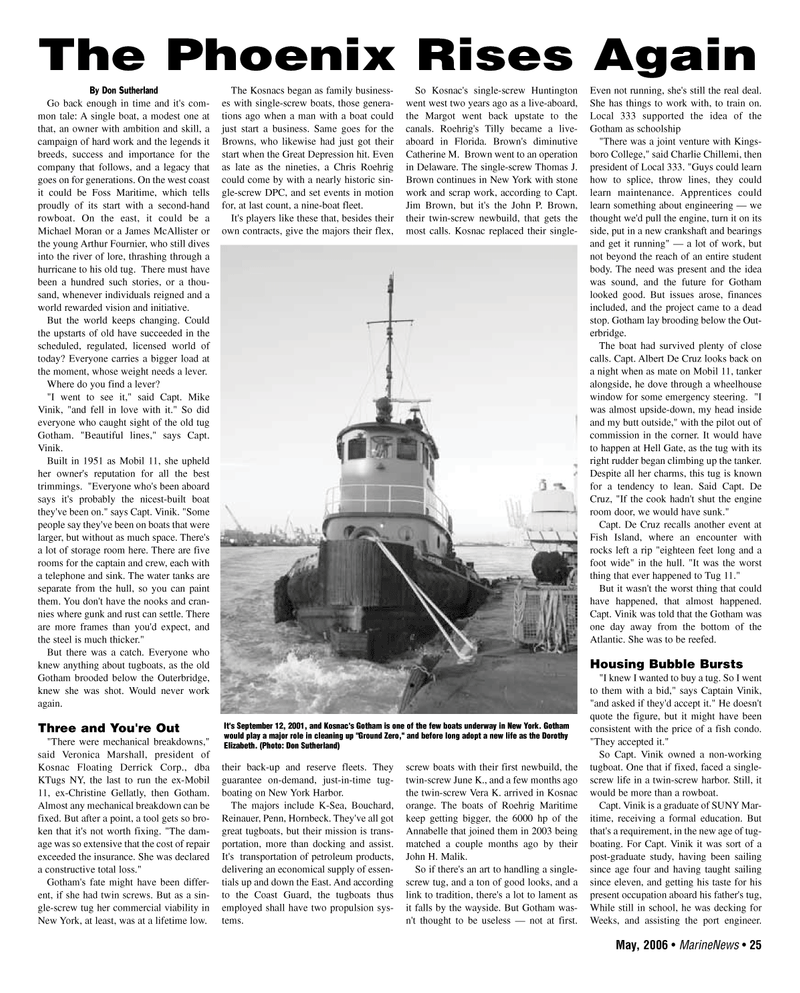
Page 25: of Marine News Magazine (May 2006)
The Combat Craft Annual
Read this page in Pdf, Flash or Html5 edition of May 2006 Marine News Magazine
By Don Sutherland
Go back enough in time and it's com- mon tale: A single boat, a modest one at that, an owner with ambition and skill, a campaign of hard work and the legends it breeds, success and importance for the company that follows, and a legacy that goes on for generations. On the west coast it could be Foss Maritime, which tells proudly of its start with a second-hand rowboat. On the east, it could be a
Michael Moran or a James McAllister or the young Arthur Fournier, who still dives into the river of lore, thrashing through a hurricane to his old tug. There must have been a hundred such stories, or a thou- sand, whenever individuals reigned and a world rewarded vision and initiative.
But the world keeps changing. Could the upstarts of old have succeeded in the scheduled, regulated, licensed world of today? Everyone carries a bigger load at the moment, whose weight needs a lever.
Where do you find a lever? "I went to see it," said Capt. Mike
Vinik, "and fell in love with it." So did everyone who caught sight of the old tug
Gotham. "Beautiful lines," says Capt.
Vinik.
Built in 1951 as Mobil 11, she upheld her owner's reputation for all the best trimmings. "Everyone who's been aboard says it's probably the nicest-built boat they've been on." says Capt. Vinik. "Some people say they've been on boats that were larger, but without as much space. There's a lot of storage room here. There are five rooms for the captain and crew, each with a telephone and sink. The water tanks are separate from the hull, so you can paint them. You don't have the nooks and cran- nies where gunk and rust can settle. There are more frames than you'd expect, and the steel is much thicker."
But there was a catch. Everyone who knew anything about tugboats, as the old
Gotham brooded below the Outerbridge, knew she was shot. Would never work again.
Three and You're Out "There were mechanical breakdowns," said Veronica Marshall, president of
Kosnac Floating Derrick Corp., dba
KTugs NY, the last to run the ex-Mobil 11, ex-Christine Gellatly, then Gotham.
Almost any mechanical breakdown can be fixed. But after a point, a tool gets so bro- ken that it's not worth fixing. "The dam- age was so extensive that the cost of repair exceeded the insurance. She was declared a constructive total loss."
Gotham's fate might have been differ- ent, if she had twin screws. But as a sin- gle-screw tug her commercial viability in
New York, at least, was at a lifetime low.
The Kosnacs began as family business- es with single-screw boats, those genera- tions ago when a man with a boat could just start a business. Same goes for the
Browns, who likewise had just got their start when the Great Depression hit. Even as late as the nineties, a Chris Roehrig could come by with a nearly historic sin- gle-screw DPC, and set events in motion for, at last count, a nine-boat fleet.
It's players like these that, besides their own contracts, give the majors their flex, their back-up and reserve fleets. They guarantee on-demand, just-in-time tug- boating on New York Harbor.
The majors include K-Sea, Bouchard,
Reinauer, Penn, Hornbeck. They've all got great tugboats, but their mission is trans- portation, more than docking and assist.
It's transportation of petroleum products, delivering an economical supply of essen- tials up and down the East. And according to the Coast Guard, the tugboats thus employed shall have two propulsion sys- tems.
So Kosnac's single-screw Huntington went west two years ago as a live-aboard, the Margot went back upstate to the canals. Roehrig's Tilly became a live- aboard in Florida. Brown's diminutive
Catherine M. Brown went to an operation in Delaware. The single-screw Thomas J.
Brown continues in New York with stone work and scrap work, according to Capt.
Jim Brown, but it's the John P. Brown, their twin-screw newbuild, that gets the most calls. Kosnac replaced their single- screw boats with their first newbuild, the twin-screw June K., and a few months ago the twin-screw Vera K. arrived in Kosnac orange. The boats of Roehrig Maritime keep getting bigger, the 6000 hp of the
Annabelle that joined them in 2003 being matched a couple months ago by their
John H. Malik.
So if there's an art to handling a single- screw tug, and a ton of good looks, and a link to tradition, there's a lot to lament as it falls by the wayside. But Gotham was- n't thought to be useless — not at first.
Even not running, she's still the real deal.
She has things to work with, to train on.
Local 333 supported the idea of the
Gotham as schoolship "There was a joint venture with Kings- boro College," said Charlie Chillemi, then president of Local 333. "Guys could learn how to splice, throw lines, they could learn maintenance. Apprentices could learn something about engineering — we thought we'd pull the engine, turn it on its side, put in a new crankshaft and bearings and get it running" — a lot of work, but not beyond the reach of an entire student body. The need was present and the idea was sound, and the future for Gotham looked good. But issues arose, finances included, and the project came to a dead stop. Gotham lay brooding below the Out- erbridge.
The boat had survived plenty of close calls. Capt. Albert De Cruz looks back on a night when as mate on Mobil 11, tanker alongside, he dove through a wheelhouse window for some emergency steering. "I was almost upside-down, my head inside and my butt outside," with the pilot out of commission in the corner. It would have to happen at Hell Gate, as the tug with its right rudder began climbing up the tanker.
Despite all her charms, this tug is known for a tendency to lean. Said Capt. De
Cruz, "If the cook hadn't shut the engine room door, we would have sunk."
Capt. De Cruz recalls another event at
Fish Island, where an encounter with rocks left a rip "eighteen feet long and a foot wide" in the hull. "It was the worst thing that ever happened to Tug 11."
But it wasn't the worst thing that could have happened, that almost happened.
Capt. Vinik was told that the Gotham was one day away from the bottom of the
Atlantic. She was to be reefed.
Housing Bubble Bursts "I knew I wanted to buy a tug. So I went to them with a bid," says Captain Vinik, "and asked if they'd accept it." He doesn't quote the figure, but it might have been consistent with the price of a fish condo. "They accepted it."
So Capt. Vinik owned a non-working tugboat. One that if fixed, faced a single- screw life in a twin-screw harbor. Still, it would be more than a rowboat.
Capt. Vinik is a graduate of SUNY Mar- itime, receiving a formal education. But that's a requirement, in the new age of tug- boating. For Capt. Vinik it was sort of a post-graduate study, having been sailing since age four and having taught sailing since eleven, and getting his taste for his present occupation aboard his father's tug,
While still in school, he was decking for
Weeks, and assisting the port engineer.
May, 2006 • MarineNews 25
It's September 12, 2001, and Kosnac's Gotham is one of the few boats underway in New York. Gotham would play a major role in cleaning up "Ground Zero," and before long adopt a new life as the Dorothy
Elizabeth. (Photo: Don Sutherland)
The Phoenix Rises Again
MAY MN2006 4(25-32).qxd 5/9/2006 10:02 AM Page 25

 24
24

 26
26
